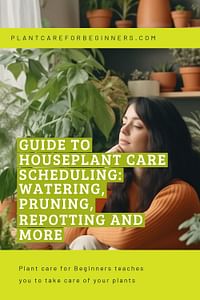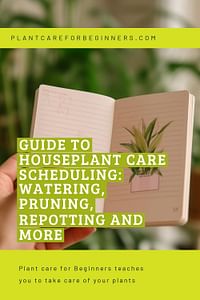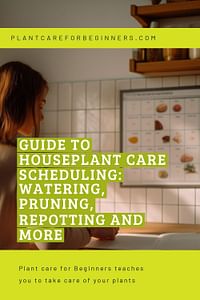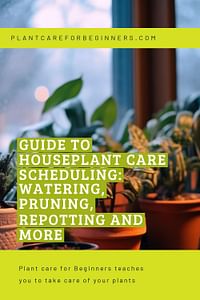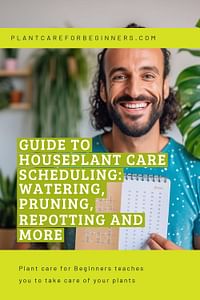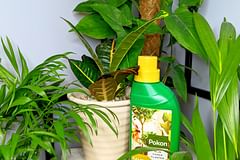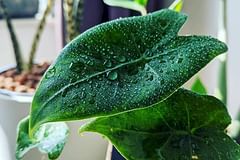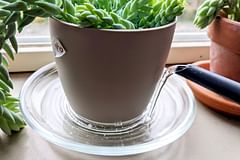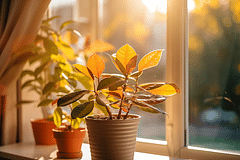Guide to Houseplant Care Scheduling: Watering, Pruning, Repotting and More
Learn how to create a houseplants calendar to keep your plants thriving! Discover when it's time to water, prune, and repot your green friends. Get expert tips from a plant care enthusiast who will guide you every step of the way. Perfect for both beginners and seasoned plant parents!

Key learnings from this plant care guide
- A well-planned houseplant calendar is essential for maintaining the health and happiness of your plants.
- Creating a houseplant calendar helps you track watering, pruning, and repotting schedules, ensuring your plants get the care they need.
- Adjusting your houseplant schedule based on the seasons helps your plants thrive throughout the year.
- Following the instructions on fertilizer labels and regularly checking soil moisture are vital for successful plant care.
Are you unsure about when to water, prune, or repot your indoor garden? Don't worry, you're not alone! Many houseplant enthusiasts, both beginners and experienced green thumbs face the same questions. The good news is that a well-planned houseplant calendar can help you solve these issues efficiently.
This guide will show you how to create a dedicated plant care calendar. It's easy to follow and eliminates guesswork from your plant care routine, ensuring your plants thrive. Grab a marker and let's get started on your houseplants calendar!
The importance of a houseplant schedule
Plants, just like us, benefit from a routine. A consistent care schedule is vital to maintain the health and happiness of your houseplants. Let's explore why plants need a schedule, the impact of irregular care, and how a houseplant calendar can optimize your plant care routine.
Why does your plant need a schedule?
Life happens, and sometimes we forget to water our plants, or worse, overwater them. Giving your plants a consistent schedule helps them adapt to your home environment and ensures they get just the right amount of water, light, and other care they need.
Without a routine, plants can become stressed, leading to health issues like yellow leaves, stunted growth, or even death. Stressed plants can't take care of themselves that well and this is when pests are the happiest. Pests love stressed plants, they're an easy target.
How a houseplants calendar can optimize your plant care regimen
A houseplants calendar is a handy tool to keep track of your plants' care routines. Simply mark down watering, feeding, or any other specific care tasks like pruning or misting. This ensures you won't forget critical care aspects, especially with a large plant collection. The calendar not only reminds you to provide care but also helps you observe patterns, identify issues early, and adjust your routine accordingly.
Perhaps your plant takes much longer to dry out than before, this could indicate a problem or tell you it's going dormant during the winter.
What is the result of all this work? Healthy and thriving houseplants in your home.
Who can benefit from this houseplant calendar?

So this houseplant calendar takes some work to set up, so is it for everyone? I think a houseplant calendar is a great idea for you, if:
- you have more than 15 houseplants
- you have many different types of plants (tropical, succulents, etc.)
- you are a very busy person
- you have trouble remembering when you last took care of your plant(s)
As you can see, a houseplant calendar is quite a good tool for most people, even if you're currently not struggling to take care of your plants. A houseplant calendar will help you catch issues quickly.
Now, let's find out how we can create a houseplant calendar that will help you take better care of your plants.
Creating a houseplant calendar
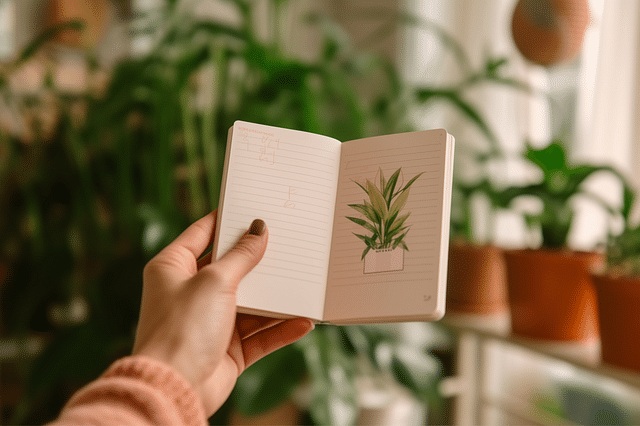
Creating a houseplants calendar is like preparing a meal plan. You want to ensure your plants get just the right amount of nutrients at the right time. This section is all about crafting a suitable watering schedule, marking the pruning periods, and deciding on repotting times to help your plants thrive.
Crafting a suitable watering schedule
Just like people, plants have differing hydration needs. Some plants need to remain slightly moist, while others prefer their soil to completely dry out between waterings. Considering these unique needs, it's essential to create a weekly watering schedule.
Research each plant's watering needs. In colder months when they're not actively growing, most houseplants prefer less water. However, during the summer with increased light and heat, watering will need to be more frequent.
Create a personalized watering calendar for your plants by writing down the name of each plant with a specific watering day next to it. You can adjust this schedule based on how your plants respond, and as the seasons change. If you'd like a notification, add the day to the calendar on your phone.
Keep in mind that the day you mark is the day on which you'll check if the plant needs water. Always check if the plant actually needs water before watering them. This will prevent overwatering.
Marking the Pruning Periods
Pruning keeps your houseplants healthy and vibrant. It involves removing dead or overgrown branches to promote new growth. Each plant has specific pruning needs, which could be difficult to plan.
For example, some flowering houseplants are best pruned right after they bloom, while some foliage plants prefer a regular light trim. Consult a plant guide or online resources to understand your plant's pruning needs, and mark these periods in your calendar.
Regularly check your plants for damaged or diseased leaves and stems. Prune them immediately, regardless of the time of year.
Deciding the repotting times
Repotting is the process of changing a plant's pot, either to a larger one (to support growth) or to a fresh one (with new soil). The best time for repotting is usually spring when most plants start their growth cycle.
However, if you notice the root ball emerging from the drain holes, or the growth of your plant has become stunted, it may be time for repotting irrespective of the season.
As with other tasks, jot down the repotting times for each of your plants on the calendar. This will help keep track of growth patterns and keep your plants healthy throughout the year.
Taking care of houseplants is a rewarding experience. With a little time, patience, and a personalized houseplant calendar, you can create a healthy and vibrant indoor garden.
Adding a fertilizer schedule to your houseplant calendar

To help your plants thrive and grow, it's important to fertilize them regularly. In this section, I'll explain why having a fertilizer schedule for your houseplants is so important. Let's get started!
Understanding the importance of fertilizing
Fertilizing is crucial for plant health and growth. Just like us, plants need a balanced diet to thrive. Fertilizers contain essential nutrients like nitrogen, phosphorus, and potassium, which promote plant health and growth. Without these nutrients, your plant may have trouble growing leaves, fighting off diseases, or producing flowers.
Deciding When and How Often to Fertilize
Houseplants don't need fertilizer daily or even weekly. They usually benefit from fertilizer every one to two months, especially during their active growing season in spring and summer. Don't overdo it, as over-fertilizing can harm your plants, causing brown and curled leaves. Always follow the fertilizer packaging instructions.
A nice trick to make fertilizing and remembering to fertilize easier is to use liquid fertilizer. You'll mix this type of fertilizer into the water you use to water your plants. This makes it a little easier to mark in your calendar as well because often this means you'll fertilize your plant every 2nd or 3rd time you water your plants.
Adapting your houseplant schedule to the seasons
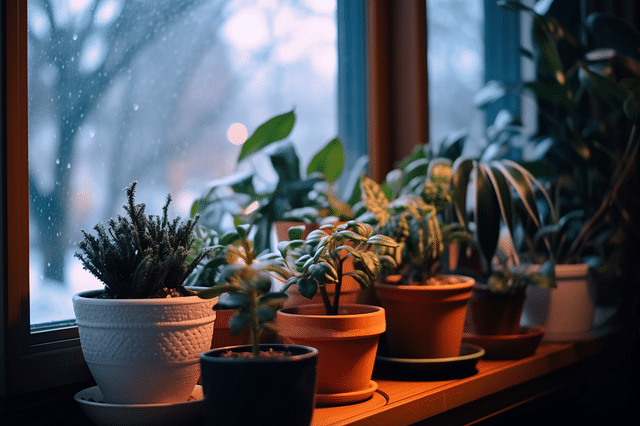
Your houseplants respond to seasonal changes, even if they're growing indoors. To help them thrive, you'll need to adjust your plant care routine throughout the different seasons. Let's look at how we can change our houseplant calendar to account for the different seasons of the year.
Changes in plant care needs by season
The different seasons bring different challenges and rewards for your houseplants. Understanding these changes will help you keep your plants thriving. Let's have a quick look at how each season impacts your plant care routine.
- Spring: As the days start getting longer, your plants wake from their winter dormancy. This is the first part of the growing seasons where they would like a bit more care and attention from you. Water your plants a little more often, feed them with a dose of fertilizer, and offer a bit more sunlight.
- Summer: This is the second part of the growing season. Be careful with direct sunlight and high heat during this time of year, because it may harm your plants. You might have to move your plant a little away from windows and water it more often. The heat will evaporate the moisture in the soil more quickly.
- Fall: As the days shorten in the fall, your plants enter a pre-dormancy phase. Because your plants are getting less sunlight and warmth, it means you should reduce your watering frequency and stop fertilizing.
- Winter: Most houseplants enter their dormancy in winter. They need very little water and no fertilizer. Keep your plants in a space with a consistent temperature and away from warm or cold drafts.
An example of a houseplant calendar

So your houseplant needs different care for the different seasons. Let's see what this means for your houseplant calendar. Let's take the care routine for the spring as our starting point. As an example, let's pick the Monstera Deliciosa as our plant and see what the houseplant calendar could look like.
Spring
- Check soil moisture every 7 days
- Fertilize once every 14-30 days (depending on what the instructions on your fertilizer are)
- Keep plant close to a window for sunlight exposure
- Repot your plant if it needs repotting
- Prune your plant if it needs to be trimmed back
Summer
- Check soil moisture every 4-7 days
- Fertilize once every 14-30 days (depending on what the instructions on your fertilizer are)
- Move your plant away from windows to protect it from the hot sunlight
- Prune your plant if it needs to be trimmed back
Fall
- Check soil moisture every 7-10 days
- Don't fertilize your plant
- Move your plant closer to windows for extra sunlight
Winter
- Check soil moisture every 10-14 days
- Dont fertilizer your plant
- Keep plant close to a window for sunlight exposure
Planning these watering, fertilizer, repotting, and pruning moments is easiest when you pick a "plant care" day. My plant care day is Saturday. Every Saturday I check my plants and see if they need any care. Most of my houseplants will want water on Saturday, but sometimes, especially in the winter, the soil might still be moist. At this point, I wait until Monday to check again.
In the summer, when it's much warmer, I try to stick to watering my plants on Saturday, but I start to check the soil of my plants starting on Thursday. The moisture in the soil will evaporate more quickly, so it's good practice to check a little earlier. You only have to do this in the summer, as the fall and spring are usually cool enough to keep your plant hydrated until the next Saturday.
Of course, this is my schedule. You have to find a schedule that works for you and your plants. Taking care of plants should be a delight, not a chore.
Don't plan too far ahead
There are a few things to explain for this sample houseplant care schedule. The very first thing I'd like to look at is the soil moisture check. To keep your plant healthy, we don't want to water your plant too much or too little. This is why you always need to check the soil before watering your plants.
There are many apps available that will tell you to water your plant, but they don't tell you to check the soil first. These apps tell you "Water your plant once every 7 days". If you follow this advice without checking the soil, you will eventually overwater your plant. Always check the soil first and never water your plant if the soil is still moist at the top.
When you check the soil of your plant and it's still moist, you need to wait a few more days and check again. Because of this, I don't recommend you plan the entire year, because there will be times when the soil is dry much earlier or later. When this happens, you'll need to update the entire year. Only plan 1-2 care cycles ahead, because this helps you remember, but doesn't make it become a chore.
Follow the instructions on the label
In my example, when looking at fertilizing your houseplant, I told you to fertilize your plant every 14-30 days in the spring and summer. However, it's important to realize that not all fertilizer is made the same. This is why it's important to look at the label of the fertilizer you have at home.
For example, the manufacturers of my favorite liquid fertilizer tell me to apply the fertilizer once every 7 days. This makes it very simple to remember because, during this time of year, I check the soil moisture once every 7 days as well. Because this lines up perfectly, I don't have to think about my fertilizer schedule and can add it to the water every time my plant needs a drink.
By reading the label of your fertilizer, you might make your life a lot easier and your plants will thank you for it!
Thank you for reading this post! I hope it helps you to keep your plants healthy and beautiful! If you're looking for more guides on specific plants, you can always request a plant guide to get a guide for the plant you have trouble with.
Test your plant care knowledge
Quiz completed!
Want to learn more? Sign up for my newsletter to receive free tips in your inbox!
Sign up now!

